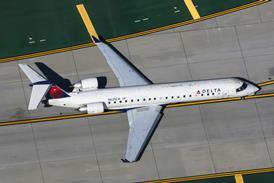Investigators have concluded that poor airmanship, notably the failure to recognise and correct an excessive bank after take-off, led to the loss of a Kenya Airways Boeing 737-800 in Cameroon three years ago.
The twin-jet departed Douala for Nairobi in darkness - without seeking or obtaining take-off clearance - on 5 May 2007.
After lifting off runway 12 the aircraft demonstrated a tendency to drift into a right bank, which was initially corrected by the captain who was the flying pilot.
Some 42sec after the 737 became airborne the captain called 'OK, command'. While this signalled the activation of the autopilot, the Cameroon Civil Aviation Authority's inquiry report states that the autopilot did not engage.
Even though there was no confirmation of the autopilot's activation - either from the first officer, the automatic annunciator, or the behaviour of the aircraft - the captain nevertheless behaved "as though the autopilot [was] effectively engaged".
Despite adjusting the heading selector and altimeter settings, the pilots failed to recognise, from the instrument panel, the aircraft's increasing bank to the right. This bank - about 11° at the time of the autopilot call - increased to 34° over the subsequent 40sec, before a 'bank angle' warning sounded in the cockpit.
The CCAA says that the captain appeared "unaware" of the bank. He expressed surprise at the alarm, and exacerbated the situation by first turning the control yoke to the right.
Instead of assessing the excessive bank, and executing procedures to recover to level flight, the captain became disorientated, activating the autopilot but making "confused movements" of the flight controls.
The right bank increased to 80° and, after reaching a height of about 2,900ft, the aircraft pitched nose-down, banking eventually to 115°.
Flight-data recorder information indicates that, at one point, the two pilots were providing conflicting inputs to the aircraft's control column: the first officer was turning the control yoke left, with nose-down, while the captain was turning it right, with nose-up.
While the first officer's actions were "corrective" and the captain's were "aggravating", the CCAA says the situation was "already beyond redemption". The jet's bank recovered to about 60° but, pitched down at 48°, it crashed into a mangrove swamp at nearly 290kt and disintegrated. There were no survivors among the 114 on board.
Flight KQ507 had been airborne for just 1min 42sec. The CCAA cites a "lack of rigour" in piloting and poor situational awareness, noting that the crew did not properly scan their instruments despite the lack of external visual references.
It adds that the pilots' "inadequate operational control" and failure to co-ordinate contributed to the accident.
- Flightglobal's original coverage of the Kenya Airways flight KQ507 that crashed in Cameroon on 5 May 2007
Source: Air Transport Intelligence news























